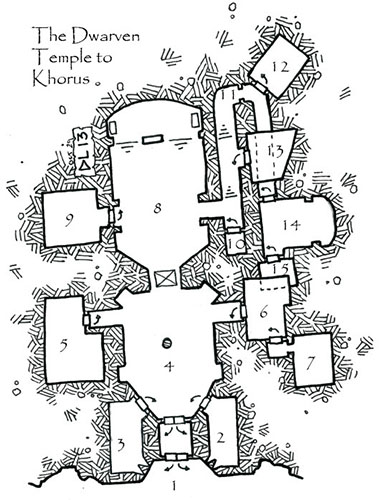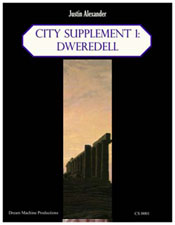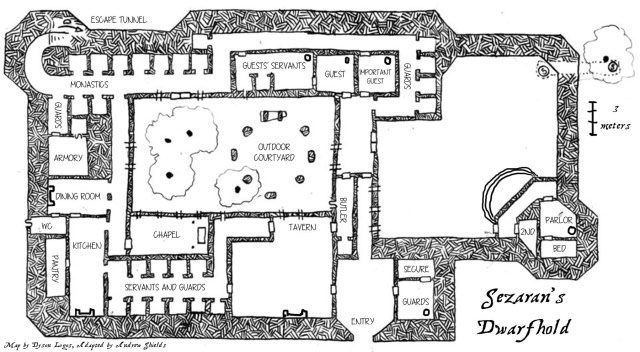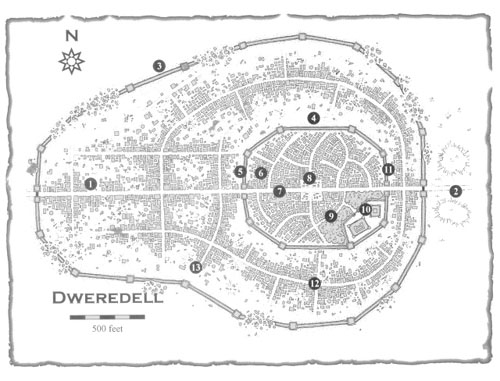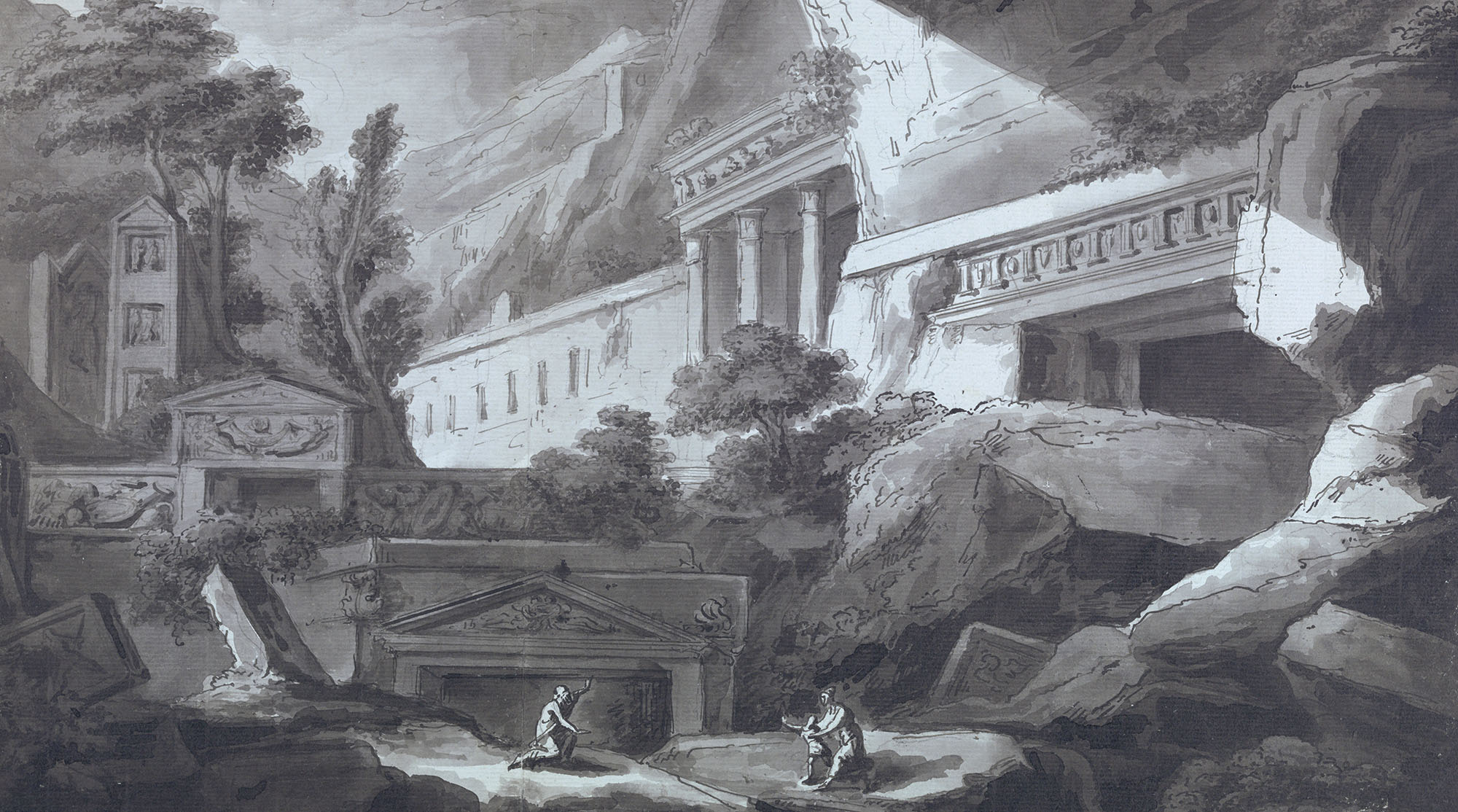
The Dweredell Project aims to expand the city-state of Dweredell, which originally appeared as a brief gazetteer you can find here, into a tri-crawl featuring a hexcrawl, megadungeon, and urbancrawl. I’m not ready to officially launch the Dweredell Project. This isn’t even really a sneak peek. But I had a request to share the gods from my campaign world, so I’m pulling this material out now.
THE PANTHEON
The pantheon of the Western Lands consists of the Nine Gods.
- Athor, the Father
- Crissa, the Mother
- Itor, God of War
- Itehl, The Trickster / God of Craft and Civilization
- Sarathyn, the Virgin Goddess / Goddess of the Void
- Sayl, the Sun Goddess / Goddess of Life and Sexuality
- Tohlen, God of Nature / God of the Harvest
- Bahl, God of the Dead
- Vehthyl, God of the Enigma / God of Knowledge (Magic and the Unknown)
The gods are commonly arranged into dualities:
- Athor and Crissa, Husband and Wife / Mother and Father. The head of the Pantheon.
- Itor and Itehl, the Twin Brothers. They have an antagonistic relationship. Sarathyn often intercedes to protect Itor from the machinations of his mischievous brother.
- Sarathyn and Sayl, the Twin Sisters. They represent the twin sides of love (chastity and sexuality).
- Bahl and Tohlen, Gods of the Climes and Seasons. Maintainers of the natural orders.
- Vehthyl, the Lone God. He set in contrast to the rest of the Pantheon.
In some teachings, alternative dualities are given. (Sarathyn andTohlen, for example, are seen as gods of ultimate negation, while Sayl and Bahl are, in some tales, locked in a forbidden love.)
Another common grouping are the Four Children (Itor, Itehl, Sarathyn, and Sayl).
PATRON ANIMALS
- Athor: Eagle
- Crissa: Hawk
- Itor: Stag
- Itehl: Snake
- Sarathyn: Dolphin
- Sayl: Wolf
- Tohlen: Bear
- Bahl: Owl
- Vehthyl: Cat
HOLY SYMBOLS
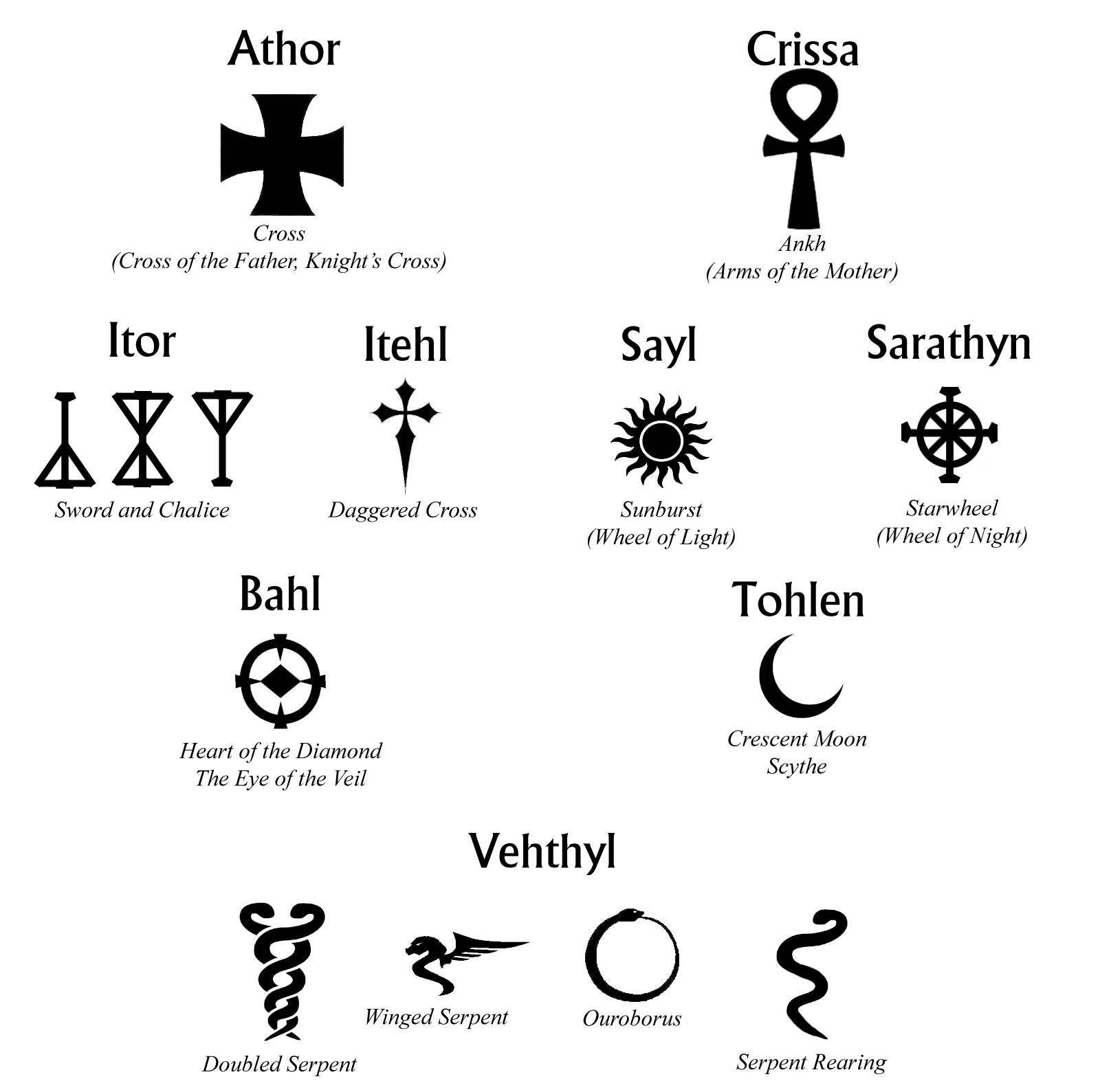
Athor – Cross. Also known as the Cross of the Father or the Knight’s Cross, Athor’s Cross is the standard badge of Pantheon worship. It is also used dominantly in many Barundian heraldries.
Crissa – Ankh. Also known as the Arms of the Mother, Crissa’s Ankh is a symbol of motherhood and compassion.
Itor – Sword and Chalice. Itor’s primary holy symbol is a sword, but when Itor’s Sword is inverted it becomes Itor’s Chalice. As the sword it’s a symbol of martial prowess. As the chalice it’s a symbol of comradery and friendship. The two symbols are often joined as one (a symbol known as the “hourglass”) in heraldry.
Itehl – Daggered Cross. More formally known as the daggered cross, Itehl’s Dagger is a symbol of practical thought and logic. It is also the symbol of betrayal.
Sayl – Sunburst. Also known as the Wheel of Light, the sunburst is a symbol of life, sexuality, and fertility.
Sarathyn – Starwheel. Also known as the Wheel of Night, the starwheel represents purity and perfection.
Bahl – Heart of the Diamond / Eye of the Veil. Although Bahl only has a singly holy symbol, it is known by two names: the Heart of the Diamond and the Eye of the Veil. It is more commonly known as the latter, with the former being an archaic usage.
Tohlen – Crescent Moon. Also referred to as Tohlen’s Scythe, the crescent moon is a harvest symbol.
Vehthyl – Silver Serpent. Vehthyl’s holy symbol is the silver serpent. It takes several forms, including the serpent doubled, the serpent rearing, the serpent crawling, the serpent winged, and ouroborus.
SAINTS & AVATARS
The Saintly Orders consist of the Living Saints who have served the Nine Gods throughout history. Each of the nine gods have a separate order. Also known as the Chosen, these devout among the faithful serve as powerful conduits for the gods to channel their influence into the world.
The saints are also thought by some to be reincarnated, or at least their portfolio of service is passed on.
The Avatars worshipped as divine heroes in the Five Empires. They are sometimes described as the first saints; sometimes as saints who served the Pantheon as the whole (instead of being chosen by individual gods). In some tales each is associated with one of the gods, making them more like other saints (and also giving rise to the legend of the Lost Two or Lost Twins, who are supposedly the missing eighth and ninth avatars).
- Taran, the King
- Khazel, the Warrior
- Dorien, the Mage
- Ratuul, the Guide
- Massahl, the Rogue
- Arathan, the Pure
- Oruk, the Barbarian
At one point the Imperial Church incorporated the stories of the Avatars into its orthodoxies, but over time a number of heresy cults came to worship the Avatars as gods themselves. In an attempt to root out these heresies during the Time of Reflection, the Church sought to sever all ties between the Avatars and the Pantheon. Once the Time of Reflection came to an end, however, this position eventually softened. The Avatars are now generally seen as servants of the Holy Order. (Although, of course, there are those who keep alive the Old Beliefs.)
THE IMPERIAL CHURCH
During the time of the Dominion, and the years of darkness which followed it, man’s memories of the gods grew dim. But the Pantheon was never truly forgotten: The power of the Nine could not be denied by even the strongest of dictators, nor their light quenched by the deepest of shadows. The old beliefs survived in rural cults and backwater rituals.
The origins of the Imperial Church lie in the tumultuous time of consolidation which followed the Wars of Empire. Hundreds of disparate fiefdoms had been roughly forged into new empires, and it remained to be seen whether they could be drawn together into a new society. Pockets of rebellion and resistance began to arise, and among the most dangerous of these were the resurgent Pantheon cults.
The resolution of this emerging crisis came during the reign of Atal the Second. Upon his deathbed, the Seer of Aldoreil, secret Master of the Crimson Cult of Vehtyhl, had prophesied the coming of the One Who Would Follow – a divine messenger from the gods who would bring form to their voiceless words. The Second Emperor, who was also a secret member of the Crimson Cult and followed the Seer as its master, formed the Council of Vehthyl and charged them with finding the One Who Would Follow.
The Council of Vehtyhl spent long years in their search before finally discovering the newborn One Who Would Follow. Atal the Second proclaimed the newborn babe Novarch, the Living Voice of the Nine Gods.
In the Novarch’s name, nine Councils were convened – one for each of the nine gods. These councils were made up of the greatest prophets, messiahs, and religious leaders of the age. Each council refined their teachings and rituals into a scripture, and at a grand Council of Councils these disparate scriptures were unified into the True Teachings of the Holy Order. Those who had refused to participate found their teachings ignored and, in many cases, deliberately suppressed. The Church, with the Emperor’s support, had declared itself the mortal will of the Holy Order upon the Many Worlds.
The next several decades saw the Church consolidate its power within the Seyrunian Empire: Countless trinity churches were built. The ranks of the priesthood swelled. The remaining Pantheon cults were ruthlessly stamped out for their heretical teachings. (It was also during this time that many of the druidic orders were forced to leave the Empire, either fleeing through the Imperial Pass or up into the barbarous lands of the north.)
Then, in 103 YD, at the dawn of the Second Imperial Century, three Merchant Princes of Arathia traveled to Seyrun in the guise of common merchant captains. They presented themselves before the Novarch and for three days they listened to his teachings. At the end of the three days, they had become faithful followers of the Imperial Church. It was the beginning of the Great Conversion.
The Imperial Church spread like wildfire through the Arathian lands. Within the decade every Arathian merchant caravan carried with it at least one priest of the Church — missionaries who spread the true teachings to every corner of the known world.
Barund’s outer lands had already become home to a significant number of the Church’s followers as a result of frequent travel beyond the Pythian. Now, with the Arathian merchants as a focal point, the faith was spreading through Barund’s inner lands as well. In 127 YD, at the request of the King, the Novarch came to Barund. After several weeks of discussion, the King, along with the entire royal family, officially converted to the true teachings of the Imperial Church. The Novarch then performed the Holy Coronation, anointing the King with his holy blood. The Line of Kings, like the Atalian Dynasty, was now recognized as a divine bloodright.
CHURCH HIERARCHY:
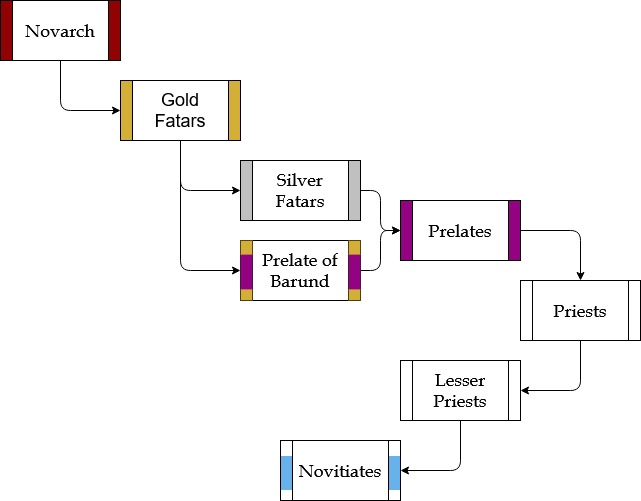
Robes:
- White with Blue Bands: Novitiates
- White: Priests
- Purple: Prelates
- Purple with Gold: Prelates of Barund
- Silver: Silver Fatar
- Gold: Gold Fatar
- Red: Novarch
Priests: Priests are also referred to as Fathers/Mothers, while Lesser Priests are known as Brothers/Sisters.
Chapels: Chapels are minor places of worship. They are watched over by Lesser Priests and typically dedicated to a particular saint.
Trinity Churches: Also known as the “lesser churches”, each trinity church is organized around a trinity of the gods. They are watched over by Priests or (in the case of more important churches) Prelates.
Solitary Churches: Unlike the trinity churches, the solitary churches (or cathedrals) are each dedicated to the worship of a single god. There are only nine solitary churches for each of the nine gods (for a total of eighty-one cathedrals). There is a solitary church for each god in each of the Seven Imperial Provinces, one within the city of Seyrun itself, and one beyond the borders of the Imperial Provinces. These last nine churches are also known as the Outer Churches, and although the original intent was to bring in an influence from beyond the heart of the empire, in practice the Outer Churches are viewed as the least among equals. The solitary churches in Seyrun itself are also known as the Imperial Cathedrals.
The Prelate of Barund: The Prelate of Barund is ostensibly the head of the Church in Barund, answerable only to the Council of Councils and the Novarch himself. However, as a result of the Twenty Year War, there are – in fact – two Prelates of Barund, one appointed by the Church; the other appointed by the King of Barund.
Nine Councils: The nine councils represent the third tier of the Church’s leadership. Each of the Solitary Churches is watched over by a Silver Fatar, and the nine Silver Fatars for each of the gods forms a council.
Council of Councils: Each of the nine councils is headed by a Gold Fatar, and the nine Gold Fatars make up the Council of Councils.
Novarch: The leader of the Church. The Living Voice of the Nine Gods.
VENNOC REFORMISTS
In 742 the King of Astalia accused the priests of the Imperial Church of espionage. After a quick trial and political stand-off, the priests were banished and the religious practices of the Church were outlawed. The charges were probably a pretense. One month later, the king issued the Reformist Proclamation, declaring that the Imperial Church had lost its way and become an instrument of Seyrun rather than the gods they were meant to serve. The Reformist Church of the Holy Order was formed shortly thereafter.
Quickly declared a heresy by the Imperial Church and banned in Seyrun, Barund, and Hyrtan, the Reformist Church nevertheless found great acceptance in Vennoc. Within a handful of years a number of other “reformist churches” had sprung up throughout the Protectorates – some seeking to “recapture” the “true meaning” of the Reformist movement, others simply seeking to reach out to the Pantheon in their own way.
Outside the Vennoc Protectorates, the Reformists were initially rebuffed – even in Arathia, although the Arathian government never banned their practices. In 751, however, after the outbreak of the Twenty Year War, Barund lifted its ban on the Reformists. Although the Barundians were still resistant to the Reformist beliefs, this meant that the end of the Twenty Year War opened a gateway to the Borderlands for the movement.
During the Twenty Year War, the Reformist movement had slowly grown strong in Vennoc. Now, in the Borderlands, as in Vennoc, the Reformists were able to take root. As the movement grew in the Borderlands, it also began to spread back into Arathia as Arathian merchants brought the movement back with them.
In recent years, the movement has even found adherents among the lands of the Hyrtanian Alliance, and Hyrtan’s outright ban on the Reformist churches has been weakened to a set of strict mandates. Only in Seyrun does the ban on the Reformists remain absolute, and even there the Reformists have been making inroads. Secret inroads, but inroads nonetheless.
EXAMPLE REFORMIST CHURCHES
Reformist Church of the Holy Order: There are no less than a half dozen churches known as the Reformist Church of the Holy Order. Many state-backed Reformist Churches were created by the rulers of the various Protectorates in the early days of the movement – either as a personal means of severing their ties to the Imperial Church, or as a direct response to Astalia’s actions. Many of these have faded away. Others became independent entities, and most of those have since joined with the original Reformist Church, still based in Astalia.
The People’s Councils: A recent creation of the Reformist movement are the People’s Councils. The People’s Councils believe that the Nine Councils should be true democracies, with all of the faithful participating in each decision. Although popular to some extent, the movement has currently stagnated on logistical problems: They can’t figure out how to organize themselves into anything other than a local group without sacrificing their tenets.
Reformist Church of the Mother and the Father: One of the earliest of the Reformist churches, the Reformist Church of the Mother and the Father believes that Athor and Crissa hold a pre-eminent place within the Holy Order. They believe that the only true means of reaching out to the gods is through the Mother and the Father.
Church of the Three Trinities: Believes that Athor/Crissa/Itor, Sarathyn/Sayl/Bahl, and Itehl/Vehthyl/Tohlen are each individual gods. The doctrine of the Church is confused, but since the religious practices include massive weekly orgies, it’s proven to be quite popular among certain segments of the population. It’s generally laughed at and ignored by the other churches (although the Imperial Church, of course, frowns on it particularly).
Church of the Twin Sisters: Worships Sarathyn and Sayl. Extremely matriarchal.
EXAMPLE REFORMIST CULTS
Order of the Oak: The Order of the Oak worships Sarathyn and Tohlen as harvest gods. (Their interpretation of Sarathyn is… odd.) The Order of the Oak is primarily known among the agricultural villages of Amsyr.
The Cult of Jade: The worship of the Cult of Jade revolves around tiny jade miniature of the nine gods. The cult recognizes nine different types of jade, and each of the nine gods is said to possess “nine faces” – the Nine Faces of the Nine Gods – each represented by a different type of jade. (Crimson Jade, Black Jade, Green Jade, Gold Jade, White Jade, Blue Jade, Violet Jade, Silver Jade, and Diamond Jade)
HOLY BOOKS
The first Council of Councils organized the scripture of the Pantheon into nine texts, each named after one of the gods: the Book of Athor, Book of Crissa, and so forth.
Design Note: By and large, I have intentionally left large swaths of these holy books as terra incognito, giving myself — and others now! — plenty of room to insert whatever we need. A good example of this is when the time came for me to flesh out the Orders of Knighthood.
ORDERS OF KNIGHTHOOD
Any order of knighthood has three things in common:
- They follow the Code of Law as laid down in the Book of Athor.
- They adhere to the Martial Code as laid down in the Book of Itor.
- They honor the Seven Compassions as laid down in the Book of Crissa.
The Code of Law is your bedrock “thou shalt not” stuff: Don’t murder, steal, enslave your brother, and so forth.
The Martial Code is essentially your standard chivalric ideal: Face your opponent fairly and honorably.
The Seven Compassions are a bit more philosophically complex, and are also referred to in some commentaries as the Seven Cares. The compassions are of the self, the companion, the stranger, the task, the thought, the memory, and the true. In other words, care for yourself, for your companions, and for stranger. Take care with what you do and what you think, and it shall be remembered. And if you can do all of that, then you will know true compassion. (For most people, the Seven Compassions boil down to “be nice to people” and “think before your act.”)
Collectively these are also known as the Way of Knighthood.
THE DEEDS OF HONOR: Although not an official part of the Way of Knighthood, the Deeds of Honor are intimately tied to the popular conception of “what it means to be a knight.”
The Deeds of Honor, as written in the Book of Itor, are a collection of legendary tales of valor, honor, bravery, and faith. In some ways they serve as a kind of “scorecard” or exemplar of heroic actions. “He lives his life by the deeds of honor” is a common saying.

